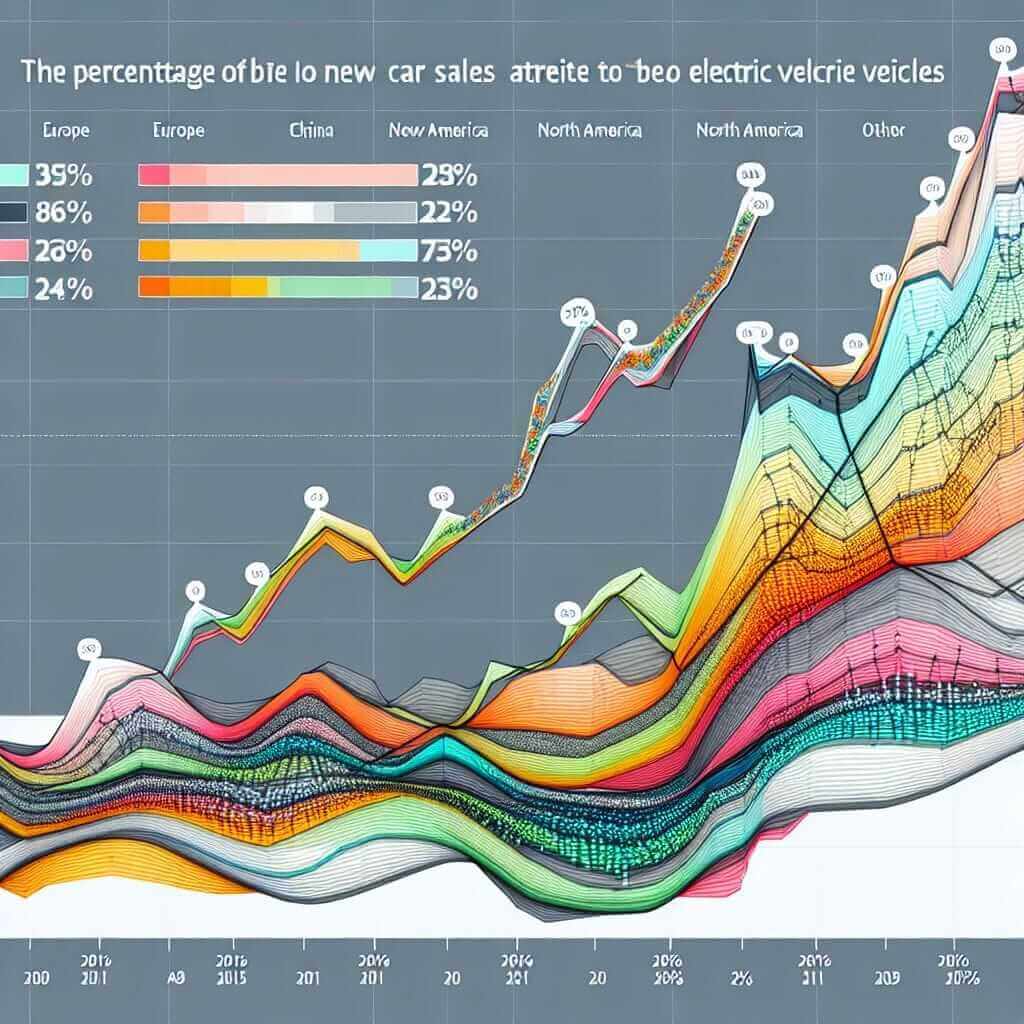The shift towards sustainable transportation is driving a global surge in electric vehicle (EV) adoption. Understanding the regional variations in this trend is crucial for policymakers, manufacturers, and investors alike. This essay will delve into the “Electric Vehicle Adoption in Different Regions (2015-2023)” theme, a topic frequently appearing in IELTS Writing Task 1. We will analyze real-world data, provide a model answer, and equip you with essential vocabulary and grammar tips to conquer this essay type.
Nội dung bài viết
Sample IELTS Writing Task 1 Question
The chart below shows the percentage of new car sales that were electric vehicles in different regions of the world between 2015 and 2023.
Summarize the information by selecting and reporting the main features and make comparisons where relevant.
(Insert a table or chart here illustrating the percentage of new electric car sales across various regions globally from 2015 to 2023. Ensure the data showcases clear trends and variations between regions.)

Data Analysis
The provided chart depicts the percentage of new car sales attributed to electric vehicles across different regions from 2015 to 2023.
- Overall Trend: There is a clear upward trend in EV adoption globally.
- Regional Variations: Europe and China consistently demonstrate higher adoption rates compared to North America and other regions.
- Notable Changes: China exhibits the most dramatic increase in EV sales, particularly after 2020.
Model Answer
The provided chart illustrates the percentage of new car sales represented by electric vehicles (EVs) in various regions worldwide from 2015 to 2023. Overall, there has been a notable increase in the adoption of EVs globally, albeit with significant regional variations.
Europe consistently maintained the highest proportion of EV sales throughout the period. Starting at around 5% in 2015, the figure rose steadily to reach approximately 20% by 2023. China followed a similar trajectory, albeit with a more dramatic surge in EV adoption, particularly after 2020. By 2023, China’s EV sales constituted nearly 25% of new car sales.
In contrast, North America lagged behind Europe and China, with EV sales hovering around 2% in 2015 and reaching only about 10% by 2023. Other regions of the world showed even slower adoption rates, remaining below 5% throughout the period.
In conclusion, while the global automotive market is shifting towards electric vehicles, the pace of this transition varies considerably across different regions. Europe and China are leading the charge, while North America and other regions are gradually catching up.
(Word count: 175 words)
Key Points for Writing Task 1
- Paraphrase the question: Don’t copy the question word-for-word. Use synonyms and rephrase to demonstrate your vocabulary.
- Highlight key trends: Focus on the most significant information. Don’t feel the need to describe every single detail.
- Compare and contrast: Identify similarities and differences between regions or data sets.
- Use appropriate vocabulary: Employ words and phrases specific to describing trends, such as “increase,” “decrease,” “fluctuate,” “plateau,” “surge,” etc.
- Accurate grammar and structure: Use correct tenses and ensure your essay is well-organized with clear paragraphs.
Challenging Vocabulary
- Adoption (noun) /əˈdɑːpʃən/: The act of starting to use something new.
- Sustainable (adjective) /səˈsteɪnəbl/: Able to be maintained at a certain rate or level.
- Trajectory (noun) /trəˈdʒektəri/: The path followed by something.
- Surge (noun) /sɜːrdʒ/: A sudden and great increase.
- Lag behind (verb) /læɡ bɪˈhaɪnd/: To move or develop more slowly than others.
- Hover (verb) /ˈhʌvər/: To remain at or near a particular level.
- Transition (noun) /trænˈzɪʃən/: The process of changing from one state or condition to another.
- Considerably (adverb) /kənˈsɪdərəbli/: To a great extent; significantly.
- Albeit (conjunction) /ɔːlˈbiːɪt/: Although; even though.
- Constitute (verb) /ˈkɑːnstɪtuːt/: To be the parts that together form something.
Conclusion
Mastering IELTS Writing Task 1 requires a combination of analytical skills, vocabulary, and grammatical accuracy. By understanding the trends in electric vehicle adoption and practicing your writing skills with real-world data, you can approach this section of the IELTS with confidence and aim for a Band 7+ score.